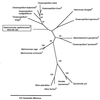Polycyclic aromatic hydrocarbon degradation by a new marine bacterium, Neptunomonas naphthovorans gen. nov., sp. nov
- PMID: 9872786
- PMCID: PMC91009
- DOI: 10.1128/AEM.65.1.251-259.1999
Polycyclic aromatic hydrocarbon degradation by a new marine bacterium, Neptunomonas naphthovorans gen. nov., sp. nov
Abstract
Two strains of bacteria were isolated from creosote-contaminated Puget Sound sediment based on their ability to utilize naphthalene as a sole carbon and energy source. When incubated with a polycyclic aromatic hydrocarbon (PAH) compound in artificial seawater, each strain also degraded 2-methylnaphthalene and 1-methylnaphthalene; in addition, one strain, NAG-2N-113, degraded 2,6-dimethylnaphthalene and phenanthrene. Acenaphthene was not degraded when it was used as a sole carbon source but was degraded by both strains when it was incubated with a mixture of seven other PAHs. Degenerate primers and the PCR were used to isolate a portion of a naphthalene dioxygenase iron-sulfur protein (ISP) gene from each of the strains. A phylogenetic analysis of PAH dioxygenase ISP deduced amino acid sequences showed that the genes isolated in this study were distantly related to the genes encoding naphthalene dioxygenases of Pseudomonas and Burkholderia strains. Despite the differences in PAH degradation phenotype between the new strains, the dioxygenase ISP deduced amino acid fragments of these organisms were 97.6% identical. 16S ribosomal DNA-based phylogenetic analysis placed these bacteria in the gamma-3 subgroup of the Proteobacteria, most closely related to members of the genus Oceanospirillum. However, morphologic, physiologic, and genotypic differences between the new strains and the oceanospirilla justify the creation of a novel genus and species, Neptunomonas naphthovorans. The type strain of N. naphthovorans is strain NAG-2N-126.
Figures

 , NAG-2N-113, 2.5 h; ▨, negative
control, 24 h; □, NAG-2N-113, 24 h. Abbreviations: NAH,
naphthalene; 1-MN, 1-methylnaphthalene; 2-MN, 2-methylnaphthalene; DMN,
2,6-dimethylnaphthalene; BPH, biphenyl; ACEN, acenaphthene; FLUO,
fluorene; PHEN, phenanthrene. Error bars represent one standard
deviation.
, NAG-2N-113, 2.5 h; ▨, negative
control, 24 h; □, NAG-2N-113, 24 h. Abbreviations: NAH,
naphthalene; 1-MN, 1-methylnaphthalene; 2-MN, 2-methylnaphthalene; DMN,
2,6-dimethylnaphthalene; BPH, biphenyl; ACEN, acenaphthene; FLUO,
fluorene; PHEN, phenanthrene. Error bars represent one standard
deviation.


References
-
- Blumer M. Polycyclic aromatic hydrocarbons in nature. Sci Am. 1976;234:35–45. - PubMed
-
- CH2M Hill. Final remedial investigation report for Eagle Harbor Site, Kitsap County, Washington, November 1989. Contract 68-01-7251. Washington, D.C: Environmental Protection Agency, Hazardous Site Control Division; 1989.
-
- Dauga C, Gillis M, Vandamme P, Ageron E, Grimont F, Kersters K, de Mahenge C, Peloux Y, Grimont P A D. Balneatrix alpicagen. nov., sp. nov., a bacterium associated with pneumonia and meningitis in a spa therapy centre. Res Microbiol. 1993;144:35–46. - PubMed
-
- Dyksterhouse S E, Gray J P, Herwig R P, Lara J C, Staley J T. Cycloclasticus pugetiigen. et sp. nov., an aromatic hydrocarbon-degrading bacterium from marine sediments. Int J Syst Bacteriol. 1995;45:116–123. - PubMed
Publication types
MeSH terms
Substances
Associated data
- Actions
- Actions
- Actions
Grants and funding
LinkOut - more resources
Full Text Sources
Molecular Biology Databases

